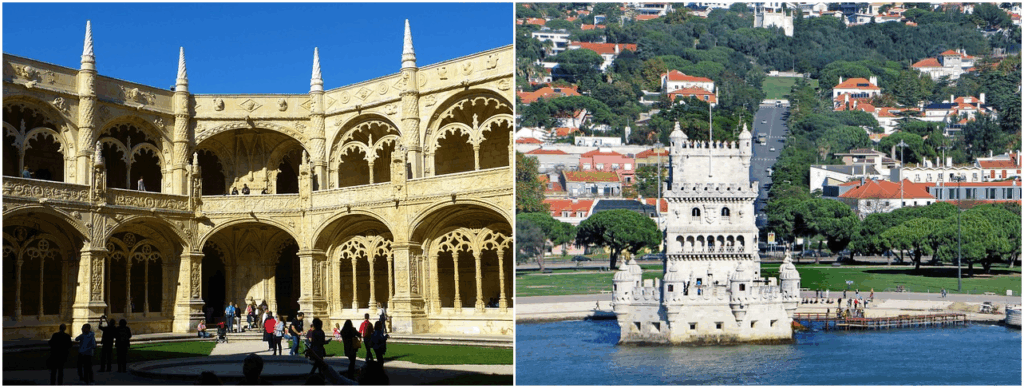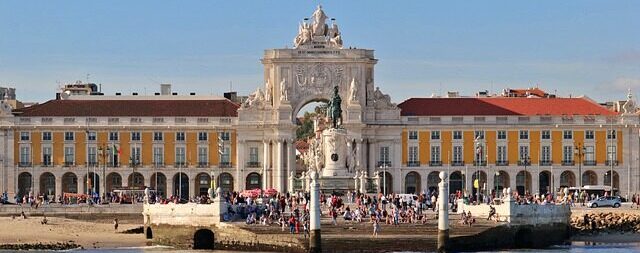Lisbon, a city draped across seven majestic hills overlooking the shimmering Tagus River, hums with a captivating blend of old-world charm and vibrant contemporary energy. Its sun-drenched streets, adorned with intricate azulejo tiles and echoing with the melancholic strains of Fado, invite exploration and promise a sensory feast. More than just its captivating capital, however, Portugal offers a wealth of diverse landscapes and cultural treasures within easy reach of Lisbon, making it the perfect base for an unforgettable Iberian adventure.
Unveiling Lisbon’s Treasures:
Embarking on a journey through Lisbon is like stepping into a living postcard. Each neighborhood boasts its own distinct character, offering a unique facet of the city’s soul.

Alfama: The city’s oldest district, Alfama, is a labyrinth of narrow, winding streets that climb steeply towards São Jorge Castle. Here, laundry flutters from wrought-iron balconies, the aroma of grilling sardines fills the air, and the soulful sounds of Fado music drift from intimate tascas (traditional taverns). Lose yourself in its charming alleys, discover hidden courtyards, and soak in the authentic atmosphere that has remained largely unchanged for centuries. Don’t miss a visit to the Lisbon Cathedral (Sé de Lisboa), a magnificent Romanesque structure that has survived earthquakes and stands as a testament to the city’s resilience. Ascend to São Jorge Castle for panoramic views that stretch across the terracotta rooftops to the vast expanse of the Tagus.
Baixa: The elegant downtown district, Baixa, was meticulously rebuilt after the devastating 1755 earthquake. Its grid-like streets are lined with grand neoclassical buildings, bustling squares, and charming cafes. Praça do Comércio, a majestic square opening onto the Tagus, is a must-see, once the gateway to the city for maritime trade. Admire the triumphal Arco da Rua Augusta and stroll along Rua Augusta, a pedestrianized street filled with shops and street performers. Take a ride on the iconic Santa Justa Lift, an ornate iron elevator offering breathtaking views of the Baixa district and São Jorge Castle.

Belém: Located west of the city center, Belém is home to several iconic landmarks that celebrate Portugal’s Age of Discoveries. The magnificent Jerónimos Monastery, a UNESCO World Heritage site, is a stunning example of Manueline architecture, adorned with intricate maritime motifs. Nearby stands the imposing Belém Tower, a 16th-century fortress that once guarded the entrance to the Tagus. Indulge in the famous Pastéis de Belém (custard tarts) at the Fábrica dos Pastéis de Belém, a tradition that dates back centuries. Don’t miss the modern Monument to the Discoveries (Padrão dos Descobrimentos), which pays homage to Portugal’s seafaring explorers.
Chiado: Known for its theaters, bookstores, and historic cafes, Chiado is Lisbon’s cultural heart. Browse the literary treasures at Bertrand, the world’s oldest bookstore, and soak in the atmosphere at Café A Brasileira, where the ghost of Fernando Pessoa, Portugal’s most celebrated poet, seems to linger. Explore the elegant shops and art galleries that line the Rua Garrett.
Bairro Alto: By day, Bairro Alto is a relatively quiet neighborhood with colorful buildings and independent boutiques. However, as dusk descends, it transforms into Lisbon’s vibrant nightlife hub. Hundreds of tiny bars and restaurants spill onto the streets, creating a lively and convivial atmosphere. It’s the perfect place to enjoy a casual dinner, sip on a Ginjinha (cherry liqueur), and hop between different bars until the early hours.
Check out places to stay in Lisbon on Hotels.com HERE
A Culinary Journey Through Lisbon:
Lisbon’s culinary scene is as diverse and captivating as its neighborhoods. From traditional tascas serving hearty Portuguese fare to innovative restaurants pushing culinary boundaries, there’s something to tantalize every palate.
- Seafood: Given its coastal location, Lisbon boasts an abundance of fresh seafood. Indulge in grilled sardines, a city staple, especially during the summer months. Sample the flavorful arroz de marisco (seafood rice), cataplana de marisco (seafood stew cooked in a copper pot), or polvo à lagareiro (octopus with roasted potatoes and olive oil). Head to the Docas area or the Time Out Market Lisboa for a wide array of seafood restaurants.
- Traditional Portuguese Cuisine: Explore the hearty flavors of traditional Portuguese dishes. Try the cozido à portuguesa (a rich stew with various meats and vegetables), bifana (pork sandwich marinated in garlic and white wine), or bacalhau à brás (shredded cod with potatoes, onions, and eggs). Seek out the smaller, family-run tascas in Alfama or Mouraria for an authentic culinary experience.
- Sweet Treats: No visit to Lisbon is complete without indulging in its delectable pastries. Beyond the iconic Pastéis de Belém, try the queijadas (sweet cheese tarts), bolo de arroz (rice cake), or the pastel de nata found in countless bakeries across the city.
- Dining Recommendations:
- Time Out Market Lisboa: A vibrant food hall offering a diverse range of Portuguese cuisine from top chefs and local vendors.
- Cervejaria Ramiro: A legendary seafood restaurant known for its incredibly fresh shellfish (be prepared for a potential wait).
- Tasca do Chico (Alfama): A traditional tasca offering authentic Portuguese dishes and live Fado performances.
- Cantinho do Avillez: A modern Portuguese restaurant by renowned chef José Avillez, offering innovative takes on classic dishes.
- Mini Bar Teatro: Another offering from José Avillez, this time a gastronomic bar with creative and surprising tasting menus.
Navigating the City: In-City Transportation
Lisbon’s hilly terrain can be challenging to navigate on foot, but the city boasts an efficient and charming public transportation system.

- Trams: The iconic yellow trams are a quintessential Lisbon experience. Tram 28, in particular, offers a scenic route through the historic Alfama and Graça districts. Be prepared for crowds, especially during peak season.
- Buses: A comprehensive network of buses covers the entire city and reaches areas not accessible by tram or metro.
- Metro: Lisbon’s metro system is modern, clean, and efficient, with four lines connecting major areas of the city.
- Funiculars and Elevators: For navigating the steeper hills, utilize the historic funiculars (Glória, Bica, and Lavra) and the Santa Justa Lift.
- Taxis and Ride-Sharing Services: Taxis are readily available and relatively affordable. Ride-sharing services like Uber and Bolt are also popular.
- Walking: While Lisbon is hilly, exploring its charming neighborhoods on foot is highly rewarding, allowing you to discover hidden gems and soak in the local atmosphere. Wear comfortable shoes!
Venturing Beyond Lisbon: Enchanting Side Trips:
Lisbon’s strategic location makes it an ideal base for exploring the diverse landscapes and historical treasures of central Portugal.

Nazaré: Famous for its colossal waves that attract big-wave surfers from around the globe, Nazaré is a captivating fishing town with a rich maritime heritage. Witness the awe-inspiring waves (especially during the winter months), ride the funicular up to Sítio for panoramic views, and learn about the local traditions of the colorfully dressed fishwives. Nazaré is accessible by bus from Lisbon (Sete Rios station, approximately 1.5-2 hours).
Sintra: A fairytale town nestled in the Sintra-Cascais Natural Park, Sintra is a UNESCO World Heritage site renowned for its romantic palaces, lush forests, and dramatic coastline. Explore the colorful Pena Palace, a whimsical Romanticist castle; wander through the mystical Quinta da Regaleira with its intriguing initiation wells; and discover the ancient Moorish Castle with its panoramic views. Sintra is easily accessible by train from Rossio Station in Lisbon (approximately 40 minutes).
Cascais: A charming coastal town just a short train ride from Lisbon (Cais do Sodré Station), Cascais offers beautiful beaches, a picturesque harbor, and a relaxed atmosphere. Stroll along the promenade, explore the historic center, and enjoy fresh seafood at one of the many waterfront restaurants. The Boca do Inferno (Hell’s Mouth), a dramatic cliff formation, is also worth a visit.
Óbidos: A perfectly preserved medieval walled town, Óbidos is like stepping back in time. Wander through its narrow cobblestone streets lined with whitewashed houses adorned with colorful bougainvillea, climb the ancient walls for stunning views of the surrounding countryside, and sample the local Ginjinha served in a chocolate cup. Óbidos can be reached by bus from Lisbon (Campo Grande station, approximately 1 hour).
Fátima: A significant religious site, Fátima is home to the Sanctuary of Our Lady of Fátima, attracting millions of pilgrims each year. Even for non-religious visitors, the scale and serenity of the sanctuary are impressive. Fátima is accessible by bus from Lisbon (Sete Rios station, approximately 1.5 hours).
Lisbon and its surrounding region offer a captivating blend of history, culture, natural beauty, and culinary delights. Whether you’re exploring the ancient alleys of Alfama, indulging in fresh seafood by the Tagus, or venturing to the fairytale castles of Sintra and the giant waves of Nazaré, Portugal’s vibrant capital and its enchanting surroundings promise an unforgettable travel experience. The warmth of the Portuguese people and the captivating charm of the landscape will undoubtedly leave an indelible mark on your soul, beckoning you to return and further unravel the treasures of this captivating corner of Europe.







